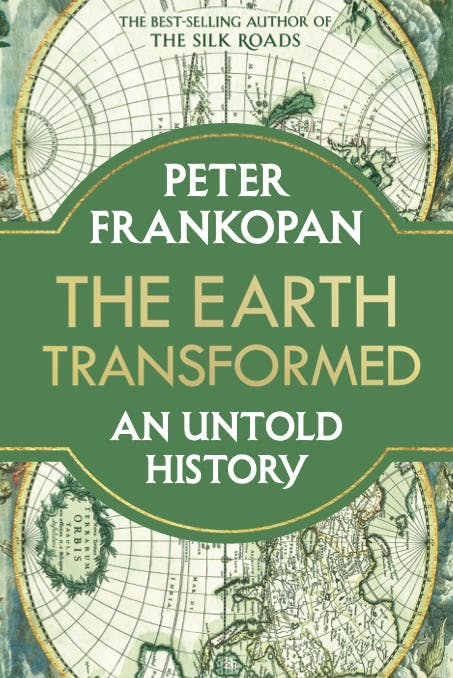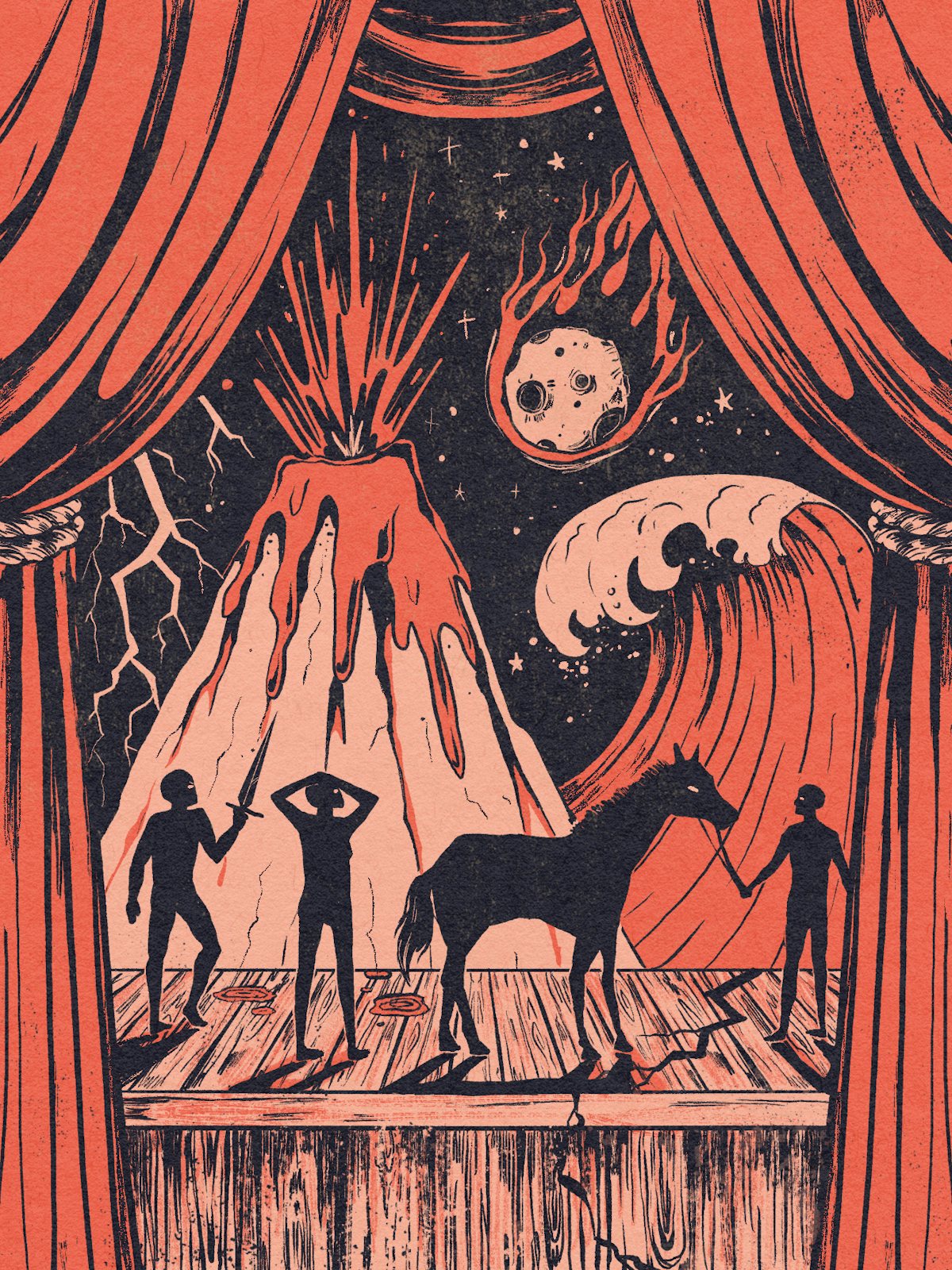Once upon a time, history was a story about men and the things that men have done to other men. Exemplary females were occasionally involved. Animals bore mention if men of sufficient renown rode them into battle. The rest of “nature”—shorthand for basically everything else in existence—was out there somewhere, a stage set for the drama. Volcanoes erupted. Rain did not fall as desired. Plagues made appearances, and the outcomes of wars were influenced here and there by harsh winters or gales at sea or foolhardy decisions involving elephants and alps. But only the most primitive imagined that the gods of the sun and goddesses of the harvest, or spirits of pestilence and storm, had any serious roles to play. Our destiny, if we had one, was in our hands alone.
These days such confidence is hard to sustain. Even as humanity alters the face of the earth—“degrading” up to 40 percent of it per a recent United Nations report—and the makeup of its atmosphere, our role as sole protagonist here is looking shakier than ever. Science has not only let us know exactly how profoundly human actions have shaped the climate; it has also provided a wealth of information about how climate has shaped us. The study of air bubbles trapped in glaciers, tree rings, fossilized pollen, and ancient DNA has revealed, in recent years, an extraordinary amount about the temperature and rainfall and composition of the atmosphere centuries or even millennia ago.

It is possible now to create parallel timelines linking historical events we have learned about secondhand—through texts, legends, and archaeological remains—to changes in the climate. Could the destruction of Sodom and Gomorrah described in the Old Testament have referred to “a cosmic airburst or multiple airbursts caused by a comet or meteorite” that appears to have leveled the Jordan Valley city of Tall el-Hammam around 1650 BCE? Scholars have linked the 2200 BCE downfall of the Akkadian empire, and contemporaneous upheavals in Egypt and elsewhere around the Mediterranean, to a period of sustained drought. One study cited by the Oxford historian Peter Frankopan in his monumental new book on climate and human history suggests that, over a 700-year period beginning in 1100 C.E., drops in growing-season temperatures of just over half a degree Fahrenheit in Europe correlated with a significantly greater probability that Jews would be persecuted over the next five years.
In The Earth Transformed: An Untold History, Frankopan, who is best known for a sweeping 2015 history of the Silk Road, takes on the ambitious and perhaps hubristic task of putting all this data together, reinserting “climate back into the story of the past” in order to lay out “the story of human interaction with the natural world over millennia.” While attuned to the momentous effects of climate, a project like this could point in several different directions. It has the potential to show how closely our lives, our history, our very being are entwined within a web of nonhuman factors, and to urge us to respond. Yet it can just as easily become a story we’ve already heard too many times, with the same protagonists as ever, depending upon how you tell it.
Given the sheer scale of the book’s objectives, its 700-page girth feels almost economical. The first chapter covers nearly 4.5 billion years, racing through the dawn of life and periodic mass extinctions. There were of course no humans around in that period, and, for a good chunk of it, not even any oxygen yet in the earth’s atmosphere, but this vast expanse of time is nonetheless everywhere with us. Geological events that took place deep in the prehuman past determined the distribution of the hydrocarbon deposits—oil and coal—that have intimately shaped the geopolitics of the last century and a half.
The millennia fly by. The glaciers recede and, about 11,700 years ago, the Holocene begins, an epoch of relatively stable weather patterns that we will surely miss. Without them, Frankopan makes clear, most of what we recognize as human society would not likely have developed. In places like Mesopotamia, Iran, China, and South America, rainfall became sufficiently reliable to make agriculture viable. Humans formed co-dependent relationships with various species of grain and legume, as well as with cattle, sheep, and goats. The archaeological record begins to show evidence of social hierarchy and growing gender inequality, not to mention outbreaks of zoonotic disease. Not everyone wins the “ecological lottery,” if all of this counts as winning: California, Frankopan points out, has a climate similar to Mesopotamia’s, but no large-seeded grasses of the sort that would eventually be domesticated elsewhere, so “plant-intensive subsistence” occurred later there, though we have recently made up for the delay.
In the seventh millennium BCE, things went wonky for a while. An ice dam collapsed over Hudson Bay, causing two huge prehistoric lakes to drain, an ice sheet to melt, and sea levels to rise. Ocean currents changed so dramatically that Northern Hemisphere temperatures plunged for a century and a half. Settlement patterns shifted. Then a landslide beneath the Norwegian Sea, likely triggered by an earthquake, unleashed a catastrophic tsunami‚ a sort of saline proto-Brexit that submerged the land mass known as Doggerland—the terrain that until then had connected Britain to mainland Europe. Frankopan leaves us to imagine what human history might have looked like without Great Britain as a sea power. Could we owe the North American genocide, the triangular trade, and the Industrial Revolution built upon its profits to a single underwater earthquake? Who’s in charge here? We are, Frankopan hurriedly assures.
Frankopan is at his most confident on the drier terrain of the Eurasian steppe, the setting of his last book. Might the domestication of horses that took place there 5,000-odd years ago have been brought about by episodic drought that pushed pastoralists to give up on herding less resilient herbivores? Maybe, but the development would prove fateful, greatly easing conquest for those tempted by such pursuits. Chariots helped win the Hittites an empire covering much of modern Turkey, northern Syria, and Lebanon; their legal code severely punished bestiality with dogs, pigs, or cows but left a stable-size loophole for intimate acts with horses. And if most premodern empires are unthinkable without cavalry, climate could help in more direct ways, too.
Enter the so-called Roman Warm Period, the centuries of exceptionally mild weather that happened to coincide with the apogee of Roman power, as well as with the Han dynasty in China and Teotihuacán in central Mexico. The two devastating pandemics that hit the Roman world in the second and third centuries C.E. occurred during inclement blips that marred this otherwise balmy time, both following closely on the heels of climate-altering volcanic eruptions. The arrival of the Huns and other nomadic people from the eastern steppes coincided with intense droughts gripping Eurasia. In Europe at least, conditions that could reliably produce agricultural surpluses would not return until the so-called Medieval Climate Optimum. Then the weather got shitty again, and another pandemic came—plague this time—and Europeans started piling into sailboats, searching out riches elsewhere.
In other, less cautious hands, this would have been a more exciting book, filled with sensational reinterpretations of familiar events, dramatic civilizational failures caused by ecological miscalculations. (Jared Diamond wrote a version of that one.) And much of it would almost certainly have been wrong. To his credit, if not often to his benefit as a narrator, Frankopan is extremely wary of analytical overstep, eager not to tumble into any too-simple climate determinism. Notions like the Roman or Medieval Warm Periods—or the later cold spell known as the Little Ice Age, which was more or less coincident with the rise of capitalist modernity—make him itchy. His virtue can be frustrating: Again and again, he lays out the evidence for one or another violent shift in climate, only to argue that it was not likely responsible, or not straightforwardly so, for this or that historical development. Psych!
Climate, for Frankopan, is only rarely a single factor in any historical development. Humans remain the star of the show here. Early on, Frankopan pins the blame on “civilization” as “by far the single greatest factor in environmental degradation and the most important cause of anthropogenic change.” It was not, for instance, dust storms and lengthy drought that caused the fall of the Akkadian empire. That more likely occurred thanks to the rigidity of “centralized political systems that were built on the demands of entrenched elites” who failed to respond to changing conditions.
His account of the rise of states is essentially one of spreading gangsterism. Elites monopolize control of resources and establish ever more complex infrastructures—bureaucratic and cultural as well as physical—to wrest wealth from the land via other humans’ labor. This “model of the city or the state as parasite,” he suggests, created a dynamic of its own, in which elite hungers require the labor of ever-greater populations, and more land to feed those laborers, and more people to work that land, etc. The problem, he repeatedly implies, is not the exploitative basis of so many early states. That, he suggests, is natural enough. Trouble arrives when their growing population densities inevitably outstrip the natural resources available to them.
If this sounds like a familiar, neo-Malthusian talking point—in heavy use among a certain strand of white, Western environmentalism since 1968’s The Population Bomb—that’s because it is. Frankopan does include some arguments against this view: He cites the Indian economist Amartya Sen, who argued that famines are not caused by shortages of food—or seen from another angle, excesses of mouths—but by political and economic structures that maintain high levels of inequality. Several pages later, though, without noticing the contradiction, he is back on the Malthusian train: The “real problem” is not climate or anything else, but “population load.” Failed harvests only became an issue, he writes, when “there were too many mouths to feed.”
This inconsistency makes a little more sense if you think of it less as a product of reasoned scholarship than of ideology poking through. With convenient sleight of hand, Malthusian logic naturalizes inequality and in the same move shifts the blame for ecological ill consequences on to the ravenous poors. It has been perennially useful, as the environmental historian Jason W. Moore points out, as “a longstanding worldview of the One Percent in eras of popular revolt and global crisis.” Such as, ahem, the current one. Frankopan, it may be worth mentioning here, is very much on Team One Percent: The son of a Croatian aristocrat, he wedded an heir to the Sainsbury’s grocery chain fortune. His sister married a royal.
I mention these domestic details only because they shed light on some otherwise unaccountable silences. The word “capitalism”—something of an important concept for understanding what makes these last few centuries different from the ones preceding them—appears only eight times in these 700 pages. This refusal to acknowledge the existence of the reigning economic order even as he describes its development becomes all the more glaring as his narrative proceeds. Suddenly and furiously, with the arrival of what the historian Alfred Crosby coyly called “the Columbian exchange,” the pace of environmental destruction picks up. Europe got tomatoes, potatoes, unimaginable quantities of mineral wealth, and the vast riches that would be squeezed from the plantation trade; the Americas got cows and horses, smallpox and measles, onions, mass enslavement, and a genocide that has not ended.
Ecological transformations began to take place at a rate never before seen in human history. Sugar cultivation, undertaken by enslaved Africans shipped across an ocean at the cost of millions of lives, denuded island after island of trees, draining aquifers and stripping away topsoil. On the North American mainland, levels of deforestation that had taken centuries to achieve in Europe occurred in decades. Fisheries were quickly depleted. The hungers of European markets spread across the globe with devastating effect, driving multiple species to near extinction because their pelts, tusks, or plumage caught the fancy of a rising class of consumers, or, more often, because they had the misfortune to live on land that had to be cleared to produce some other newly desired commodity.
Frankopan is in many ways forthright about the radical character of the “full-scale global ecological revolution” that followed, about the enormity of the wreckage, human and otherwise, that it left in its wake, and about its lasting consequences. Most of the planet’s resources still flow in paths established in the sixteenth and seventeenth centuries, from onetime colonies to the capitals of the old global empires and their offspring in North America.
In Frankopan’s telling, this is that same old story of parasitism writ large, now with planetary fallout. But although he doesn’t acknowledge it, it is easy to see from the evidence he compiles that something decisive happened around the time of the European invasions of the Americas, and that the shift that took place in the centuries that followed was a qualitative one. From the sixteenth century on, European powers obeyed a different set of impulses, serving not only the usual time-honored lust for conquest, but something altogether impersonal and alien: investment capital’s need to reproduce itself. The relations of human beings—some of them at least—to the rest of planetary life had shifted. What once had been a multitude of beings with varying cultural and spiritual significations—not to mention consciousnesses of their own—became commodities that held value only when inserted into a by-now self-propelling and endlessly expanding market.
Yet for Frankopan the difference was one of scale. Nothing fundamentally new had occurred. Many societies in the past, he writes, “had experienced problems of over-consumption, exhaustion of natural resources or strains on ecosystems.” Tendencies that until then had firm geographical limits simply globalized as European ships arrived on shore after shore. The fact that nothing that he has described in the hundreds of pages that preceded the sixteenth century remotely resembles the destruction that followed it does not appear to arouse his notice.
It is not the only curious omission. Frankopan skips right past the shift that arguably defined the modern era, and that provides much of his own conceptual framework. In the sixteenth and seventeenth centuries, in the mercantile capitals of northwest Europe, a sharper than ever division between humanity and “nature” began to emerge, and along with it, a new and uniquely inert conception of the latter. Nature became, in Moore’s words, “everything that the bourgeoisie did not wish to pay for”—land, water, plants, animals, and the labor and bodies of women, of basically all non-Europeans, who were reconceived as “savages,” and of quite a few Europeans, too. As Frankopan puts it, without a whiff of self-consciousness, “If societies were going to survive and flourish, humans would need not only to dominate nature, but to bend it to their will.”
It is hard to imagine that Frankopan has not been made aware of the wide body of scholarship—much of it from feminist, Indigenous, and Marxist traditions on which he stays resolutely silent—that has emerged to question and historicize the very man-nature divide that structures his own work. But not doing so allows him to tell a single, consistent story that unfolds over millennia. It is a tale about clever and adaptable human beings successfully dominating nature again and again—except when they do not. In this narrative, the staggering ecocidal interventions of recent centuries count only as an “acceleration.” There was, and is, no other path available, so don’t get any ideas. It comes as no surprise that Frankopan ends on a note of smug patrician doom. Perhaps we will manage to lower carbon emissions via some route other than “catastrophic depopulation,” he muses, but “a historian would not bet on it.”
If you drop the narcissistic man versus nature framing, though, another kind of story can emerge. Or really an almost infinite variety of stories about the constant and mutually reinforcing transformations of humans, microbes, ocean currents, asteroids, fungi, grasses, rivers, bison, bugs—I could go on. Many of them are here already in the pages of The Earth Transformed, obscured only by the long Promethean shadow that Frankopan attaches to the lonely figure of Man. Without it, an endless web of metamorphoses reveals itself, and the specific route that our species has taken in recent centuries appears as just one of many possible paths. Others, it is worth saying loudly, still remain to us.






